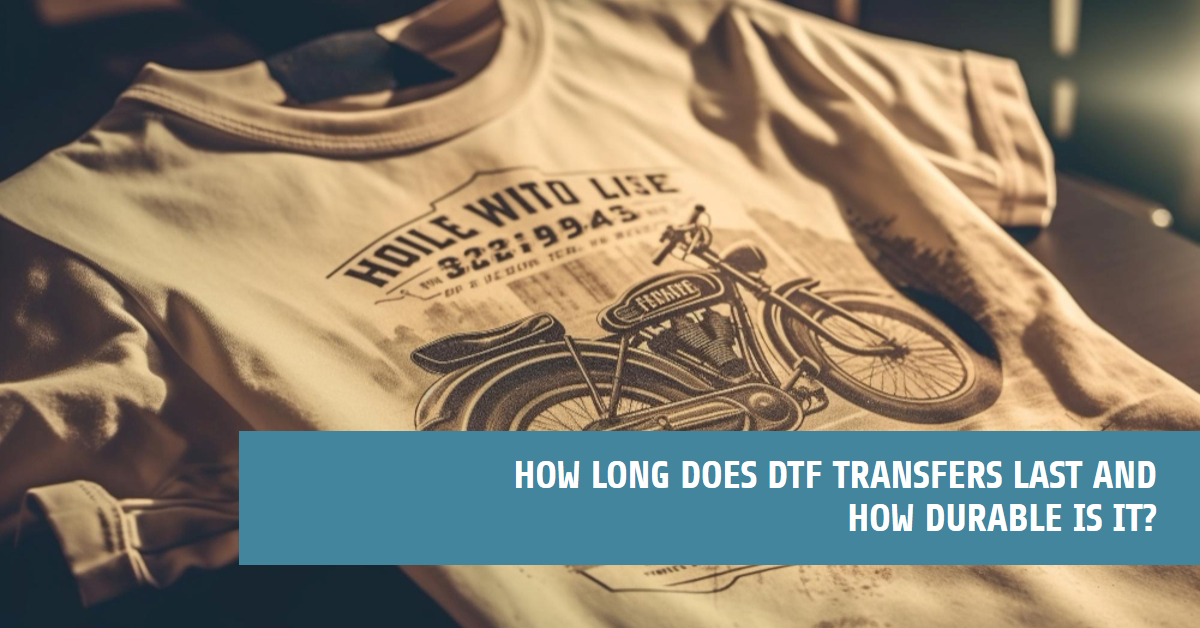DTF transfers are considered to be extremely durable; they are among the most long-lasting custom DTF transfer printing methods available. DTF prints are smooth and elastic, which ensures longevity, and they are resistant to cracking and can handle heavy use. Which can last for several washings, depending on the care instructions provided by the transfer manufacturer.
A study by the American Society for Testing and Materials (ASTM) found that DTF transfers met or exceeded all of the ASTM standards for durability, including adhesion, colorfastness, and resistance to washing and abrasion.
What Factors Affect the Durability of DTF Transfers?

The durability of DTF transfers can be affected by several factors, including:
- Quality of transfer paper or film used.
- Type of fabric the transfer is applied to.
- Care instructions are provided by the transfer manufacturer, such as turning the shirt inside out before washing and avoiding bleach.
- Type of print used, with sublimation or dye-sublimation transfer being considered more durable than traditional heat transfer vinyl or plastisol transfers.
- Quality and durability of the fabrics used.
- The pattern quality of the transfer, as low-grade hot melt powder can cause the pattern to foam and crack, reducing durability.
How to Maximize Durability of DTF Transfers on T-shirt?
To maximize the durability of DTF transfers on a T-shirt, you can follow these tips:
Use high-quality transfer materials: The longevity of the transfer will depend on the quality of the transfer paper or film. By using high-quality transfer materials, you can help ensure that your customized DTF transfers last as long as possible.
Follow the care instructions provided by the transfer manufacturer: Different transfer manufacturers may have different care instructions for their products. By following the care instructions provided by the transfer manufacturer, you can help ensure that your DTF transfers last as long as possible.
Iron the transfer properly: The heat of the iron and the duration in which it is applied when ironing the print plays a major role in the durability of the print on the fabric. Be sure to iron all the surface area of the print. Also you can hand held heat press as well. To get the best results with DTF transfers, it's essential to use a top-quality heat press. Learn how to use heat press machine.
Wash the fabric carefully: Washing the fabric can affect the durability of the transfer. Be sure to turn the T-shirt inside out so that the print does not rub against the machine or other garments. Select a mild program of 30 to 40 degree cotton or follow the care instructions provided by the transfer manufacturer.
Use DTF transfers instead of DTG: As Compared to DTF and DTG printing. While DTF prints don't have the same soft hand feel that DTG can boast, the transfers are more durable.
How Long Do DTF Transfers Last?
The longevity of DTF transfers can vary depending on several factors, including the quality of the transfer paper or film used, the type of fabric, and how the shirt is cared for. With regular use and standard washing and drying, a DTF print can typically last between 50 to 100 washes. However, some transfer manufacturers recommend turning the shirt inside out before washing and avoiding bleach to help prolong the life of the transfer.
A study by the National Institute of Standards and Technology (NIST) found that DTF transfers were more durable than screen printed transfers on a variety of fabrics, including cotton, polyester, and blends. The DTF transfers showed less fading and cracking after being subjected to multiple wash and dry cycles.
Which Printing Method is More Durable?
The durability of a print method can depend on several factors, including the quality of the ink, the type of fabric, and how the shirt is cared for. Here is a quick comparison.
| Printing method | Durability |
| Dye sublimation | Very durable, can withstand hundreds of washes |
| Screen printing | Durable, can withstand 50-100 washes |
| (DTG) printing | Less durable, can withstand 20-50 washes |
| Heat transfer vinyl (HTV) | Less durable, can withstand 20-50 washes |
| Inkjet transfer | Least durable, can withstand 10-20 washes |
| (DTF) transfer | Durable, can withstand 50-100 washes |
Additional FAQ’s
How to Properly Care for Clothing with DTF Transfers?
Proper care for clothing with DTF transfers is essential to ensure the longevity of the transfer. Here are some tips on how to properly care for clothing with DTF transfers:
- Wait 24 hours after fitting of a transfer before washing to allow the print to etch onto the garment over the next 3 days.
- Turn the garment inside out before washing to protect the transfer.
- Use cold water and a gentle wash cycle to avoid damaging both the garment and the transfer.
- Use mild detergent instead of powder detergent to avoid rubbing and straining of the transfer.
- Avoid using bleach, fabric softener, and harsh detergents, as they can damage the transfer.
- Air dry the garment instead of using a tumble dryer, as high temperatures can have an impact on the transfer.
- Keep the t-shirts turned inside out when they are exposed to the sun, as sunlight affects the vibrancy of the transfer and causes fading of the color due to photodegradation.
- When ironing the printed areas, use an iron with a low heat setting and avoid ironing directly on the transfer.
What Types of Ink that are Durable in DTF Printing?
Yes, there are specific types of ink that are known for their durability in print methods. Here are some examples.
Plastisol ink: Plastisol ink is a popular type of ink used in screen printing that is known for its durability. It is thick and can withstand several washes before fading, although it tends to crack when exposed to high heat. Plastisol ink is considered to be the most durable decoration method.
Water-based ink: Water-based ink is a great alternative to plastisol ink, as it contains lesser amounts of volatile organic compounds (VOCs) and contains simple ingredients. Water-based ink is probably the oldest eco-friendly ink around, and it’s popular for highly absorbent substrates, like corrugated paperboard. It is also easy to clean, simple to store, and compatible with elastomer image carriers.
Sublimation ink: Sublimation ink is a type of ink used in sublimation printing that is known for its durability. Sublimation printing is a process where the ink goes through a special process to penetrate the fibers of the fabric, resulting in bright and vivid designs that last a long time.

